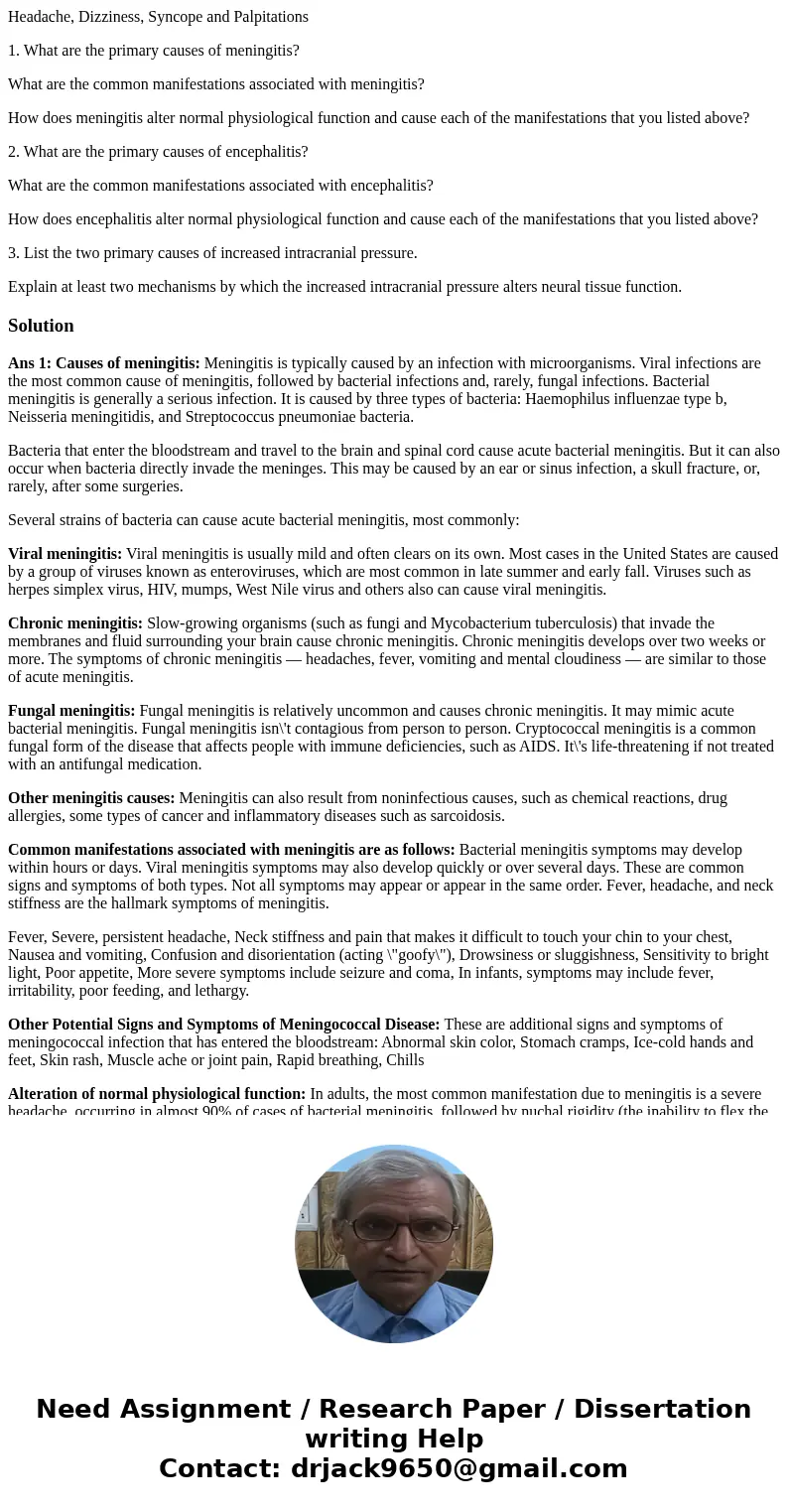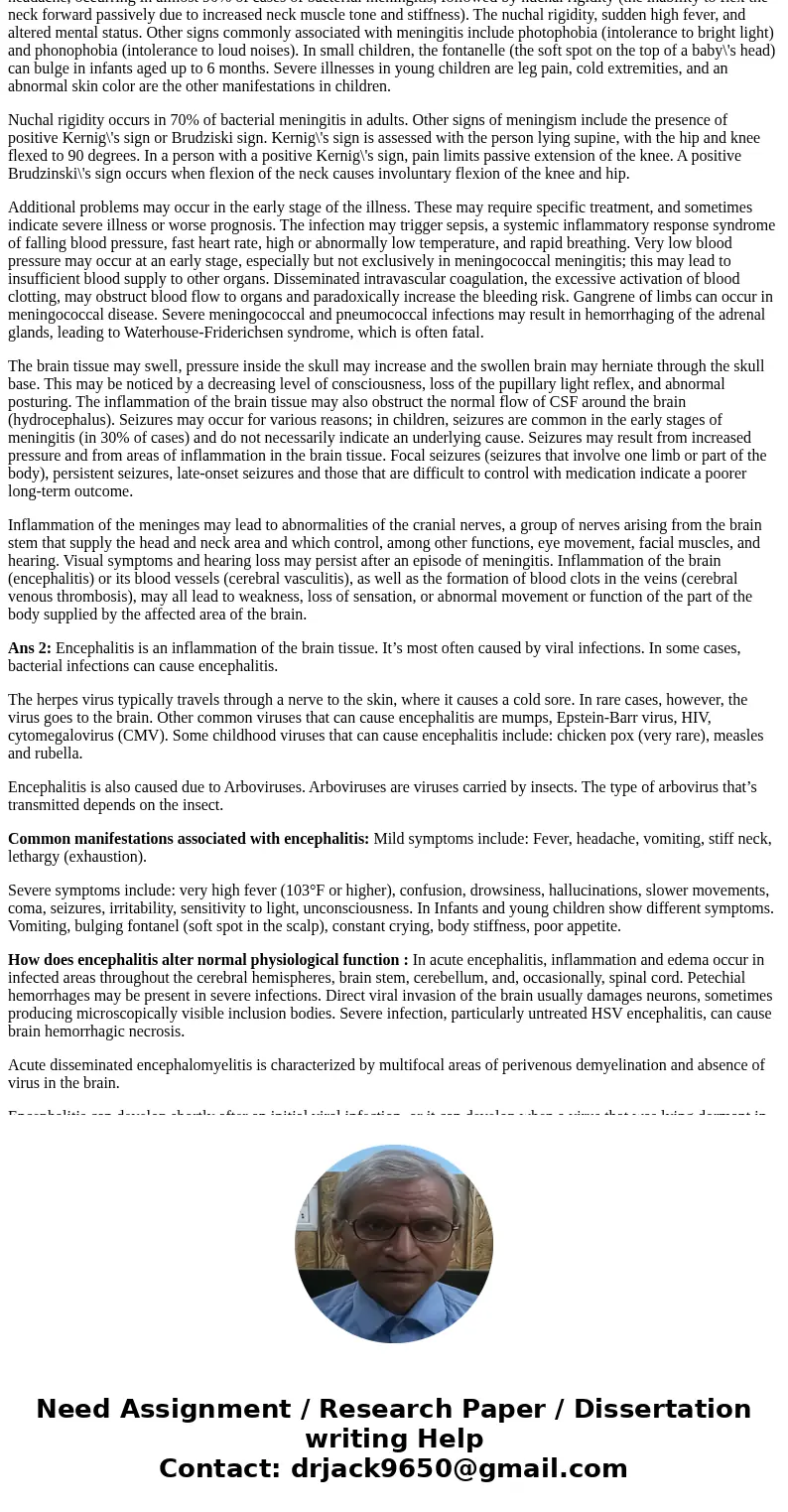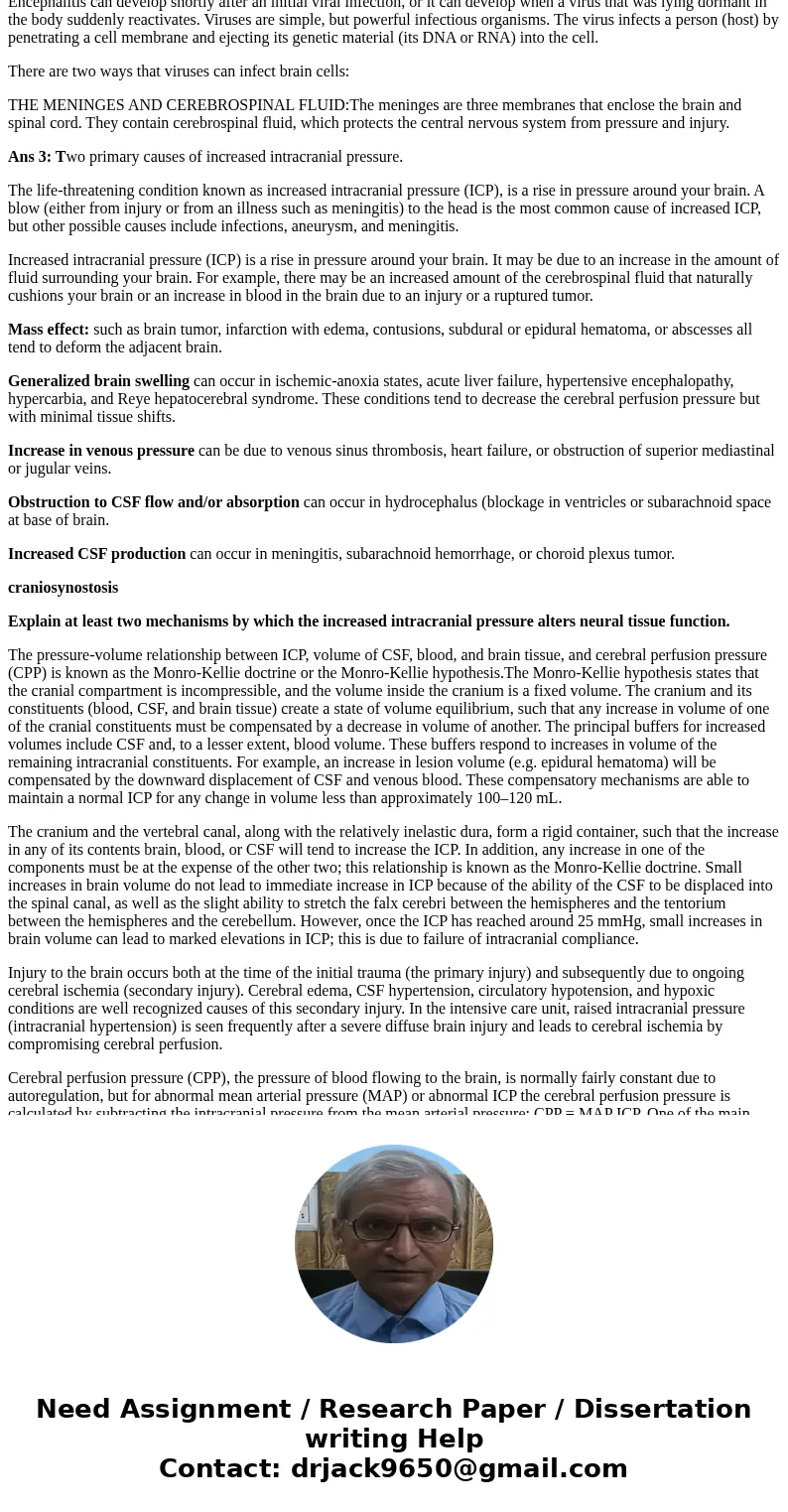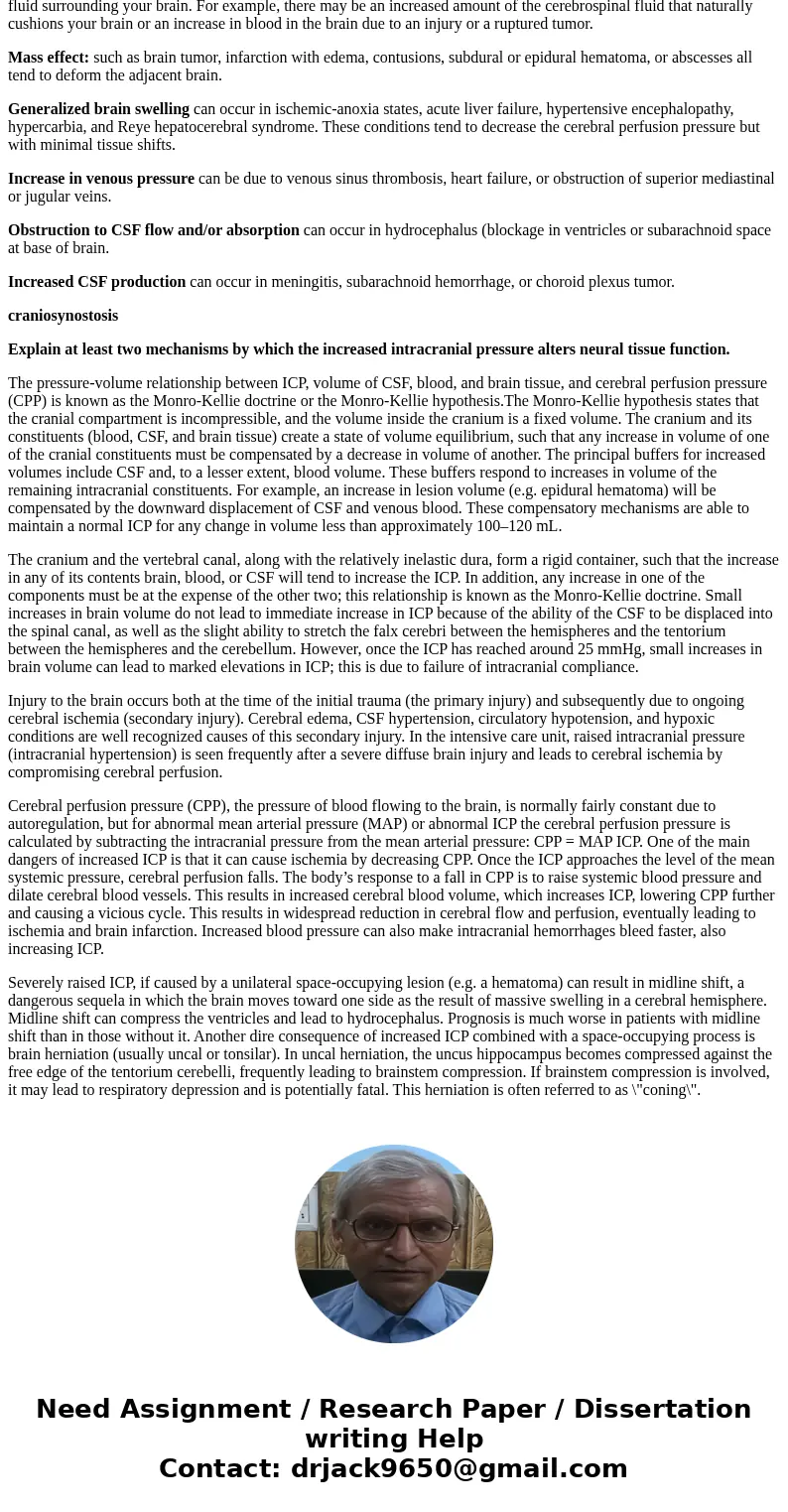Headache Dizziness Syncope and Palpitations 1 What are the p
Headache, Dizziness, Syncope and Palpitations
1. What are the primary causes of meningitis?
What are the common manifestations associated with meningitis?
How does meningitis alter normal physiological function and cause each of the manifestations that you listed above?
2. What are the primary causes of encephalitis?
What are the common manifestations associated with encephalitis?
How does encephalitis alter normal physiological function and cause each of the manifestations that you listed above?
3. List the two primary causes of increased intracranial pressure.
Explain at least two mechanisms by which the increased intracranial pressure alters neural tissue function.
Solution
Ans 1: Causes of meningitis: Meningitis is typically caused by an infection with microorganisms. Viral infections are the most common cause of meningitis, followed by bacterial infections and, rarely, fungal infections. Bacterial meningitis is generally a serious infection. It is caused by three types of bacteria: Haemophilus influenzae type b, Neisseria meningitidis, and Streptococcus pneumoniae bacteria.
Bacteria that enter the bloodstream and travel to the brain and spinal cord cause acute bacterial meningitis. But it can also occur when bacteria directly invade the meninges. This may be caused by an ear or sinus infection, a skull fracture, or, rarely, after some surgeries.
Several strains of bacteria can cause acute bacterial meningitis, most commonly:
Viral meningitis: Viral meningitis is usually mild and often clears on its own. Most cases in the United States are caused by a group of viruses known as enteroviruses, which are most common in late summer and early fall. Viruses such as herpes simplex virus, HIV, mumps, West Nile virus and others also can cause viral meningitis.
Chronic meningitis: Slow-growing organisms (such as fungi and Mycobacterium tuberculosis) that invade the membranes and fluid surrounding your brain cause chronic meningitis. Chronic meningitis develops over two weeks or more. The symptoms of chronic meningitis — headaches, fever, vomiting and mental cloudiness — are similar to those of acute meningitis.
Fungal meningitis: Fungal meningitis is relatively uncommon and causes chronic meningitis. It may mimic acute bacterial meningitis. Fungal meningitis isn\'t contagious from person to person. Cryptococcal meningitis is a common fungal form of the disease that affects people with immune deficiencies, such as AIDS. It\'s life-threatening if not treated with an antifungal medication.
Other meningitis causes: Meningitis can also result from noninfectious causes, such as chemical reactions, drug allergies, some types of cancer and inflammatory diseases such as sarcoidosis.
Common manifestations associated with meningitis are as follows: Bacterial meningitis symptoms may develop within hours or days. Viral meningitis symptoms may also develop quickly or over several days. These are common signs and symptoms of both types. Not all symptoms may appear or appear in the same order. Fever, headache, and neck stiffness are the hallmark symptoms of meningitis.
Fever, Severe, persistent headache, Neck stiffness and pain that makes it difficult to touch your chin to your chest, Nausea and vomiting, Confusion and disorientation (acting \"goofy\"), Drowsiness or sluggishness, Sensitivity to bright light, Poor appetite, More severe symptoms include seizure and coma, In infants, symptoms may include fever, irritability, poor feeding, and lethargy.
Other Potential Signs and Symptoms of Meningococcal Disease: These are additional signs and symptoms of meningococcal infection that has entered the bloodstream: Abnormal skin color, Stomach cramps, Ice-cold hands and feet, Skin rash, Muscle ache or joint pain, Rapid breathing, Chills
Alteration of normal physiological function: In adults, the most common manifestation due to meningitis is a severe headache, occurring in almost 90% of cases of bacterial meningitis, followed by nuchal rigidity (the inability to flex the neck forward passively due to increased neck muscle tone and stiffness). The nuchal rigidity, sudden high fever, and altered mental status. Other signs commonly associated with meningitis include photophobia (intolerance to bright light) and phonophobia (intolerance to loud noises). In small children, the fontanelle (the soft spot on the top of a baby\'s head) can bulge in infants aged up to 6 months. Severe illnesses in young children are leg pain, cold extremities, and an abnormal skin color are the other manifestations in children.
Nuchal rigidity occurs in 70% of bacterial meningitis in adults. Other signs of meningism include the presence of positive Kernig\'s sign or Brudziski sign. Kernig\'s sign is assessed with the person lying supine, with the hip and knee flexed to 90 degrees. In a person with a positive Kernig\'s sign, pain limits passive extension of the knee. A positive Brudzinski\'s sign occurs when flexion of the neck causes involuntary flexion of the knee and hip.
Additional problems may occur in the early stage of the illness. These may require specific treatment, and sometimes indicate severe illness or worse prognosis. The infection may trigger sepsis, a systemic inflammatory response syndrome of falling blood pressure, fast heart rate, high or abnormally low temperature, and rapid breathing. Very low blood pressure may occur at an early stage, especially but not exclusively in meningococcal meningitis; this may lead to insufficient blood supply to other organs. Disseminated intravascular coagulation, the excessive activation of blood clotting, may obstruct blood flow to organs and paradoxically increase the bleeding risk. Gangrene of limbs can occur in meningococcal disease. Severe meningococcal and pneumococcal infections may result in hemorrhaging of the adrenal glands, leading to Waterhouse-Friderichsen syndrome, which is often fatal.
The brain tissue may swell, pressure inside the skull may increase and the swollen brain may herniate through the skull base. This may be noticed by a decreasing level of consciousness, loss of the pupillary light reflex, and abnormal posturing. The inflammation of the brain tissue may also obstruct the normal flow of CSF around the brain (hydrocephalus). Seizures may occur for various reasons; in children, seizures are common in the early stages of meningitis (in 30% of cases) and do not necessarily indicate an underlying cause. Seizures may result from increased pressure and from areas of inflammation in the brain tissue. Focal seizures (seizures that involve one limb or part of the body), persistent seizures, late-onset seizures and those that are difficult to control with medication indicate a poorer long-term outcome.
Inflammation of the meninges may lead to abnormalities of the cranial nerves, a group of nerves arising from the brain stem that supply the head and neck area and which control, among other functions, eye movement, facial muscles, and hearing. Visual symptoms and hearing loss may persist after an episode of meningitis. Inflammation of the brain (encephalitis) or its blood vessels (cerebral vasculitis), as well as the formation of blood clots in the veins (cerebral venous thrombosis), may all lead to weakness, loss of sensation, or abnormal movement or function of the part of the body supplied by the affected area of the brain.
Ans 2: Encephalitis is an inflammation of the brain tissue. It’s most often caused by viral infections. In some cases, bacterial infections can cause encephalitis.
The herpes virus typically travels through a nerve to the skin, where it causes a cold sore. In rare cases, however, the virus goes to the brain. Other common viruses that can cause encephalitis are mumps, Epstein-Barr virus, HIV, cytomegalovirus (CMV). Some childhood viruses that can cause encephalitis include: chicken pox (very rare), measles and rubella.
Encephalitis is also caused due to Arboviruses. Arboviruses are viruses carried by insects. The type of arbovirus that’s transmitted depends on the insect.
Common manifestations associated with encephalitis: Mild symptoms include: Fever, headache, vomiting, stiff neck, lethargy (exhaustion).
Severe symptoms include: very high fever (103°F or higher), confusion, drowsiness, hallucinations, slower movements, coma, seizures, irritability, sensitivity to light, unconsciousness. In Infants and young children show different symptoms. Vomiting, bulging fontanel (soft spot in the scalp), constant crying, body stiffness, poor appetite.
How does encephalitis alter normal physiological function : In acute encephalitis, inflammation and edema occur in infected areas throughout the cerebral hemispheres, brain stem, cerebellum, and, occasionally, spinal cord. Petechial hemorrhages may be present in severe infections. Direct viral invasion of the brain usually damages neurons, sometimes producing microscopically visible inclusion bodies. Severe infection, particularly untreated HSV encephalitis, can cause brain hemorrhagic necrosis.
Acute disseminated encephalomyelitis is characterized by multifocal areas of perivenous demyelination and absence of virus in the brain.
Encephalitis can develop shortly after an initial viral infection, or it can develop when a virus that was lying dormant in the body suddenly reactivates. Viruses are simple, but powerful infectious organisms. The virus infects a person (host) by penetrating a cell membrane and ejecting its genetic material (its DNA or RNA) into the cell.
There are two ways that viruses can infect brain cells:
THE MENINGES AND CEREBROSPINAL FLUID:The meninges are three membranes that enclose the brain and spinal cord. They contain cerebrospinal fluid, which protects the central nervous system from pressure and injury.
Ans 3: Two primary causes of increased intracranial pressure.
The life-threatening condition known as increased intracranial pressure (ICP), is a rise in pressure around your brain. A blow (either from injury or from an illness such as meningitis) to the head is the most common cause of increased ICP, but other possible causes include infections, aneurysm, and meningitis.
Increased intracranial pressure (ICP) is a rise in pressure around your brain. It may be due to an increase in the amount of fluid surrounding your brain. For example, there may be an increased amount of the cerebrospinal fluid that naturally cushions your brain or an increase in blood in the brain due to an injury or a ruptured tumor.
Mass effect: such as brain tumor, infarction with edema, contusions, subdural or epidural hematoma, or abscesses all tend to deform the adjacent brain.
Generalized brain swelling can occur in ischemic-anoxia states, acute liver failure, hypertensive encephalopathy, hypercarbia, and Reye hepatocerebral syndrome. These conditions tend to decrease the cerebral perfusion pressure but with minimal tissue shifts.
Increase in venous pressure can be due to venous sinus thrombosis, heart failure, or obstruction of superior mediastinal or jugular veins.
Obstruction to CSF flow and/or absorption can occur in hydrocephalus (blockage in ventricles or subarachnoid space at base of brain.
Increased CSF production can occur in meningitis, subarachnoid hemorrhage, or choroid plexus tumor.
craniosynostosis
Explain at least two mechanisms by which the increased intracranial pressure alters neural tissue function.
The pressure-volume relationship between ICP, volume of CSF, blood, and brain tissue, and cerebral perfusion pressure (CPP) is known as the Monro-Kellie doctrine or the Monro-Kellie hypothesis.The Monro-Kellie hypothesis states that the cranial compartment is incompressible, and the volume inside the cranium is a fixed volume. The cranium and its constituents (blood, CSF, and brain tissue) create a state of volume equilibrium, such that any increase in volume of one of the cranial constituents must be compensated by a decrease in volume of another. The principal buffers for increased volumes include CSF and, to a lesser extent, blood volume. These buffers respond to increases in volume of the remaining intracranial constituents. For example, an increase in lesion volume (e.g. epidural hematoma) will be compensated by the downward displacement of CSF and venous blood. These compensatory mechanisms are able to maintain a normal ICP for any change in volume less than approximately 100–120 mL.
The cranium and the vertebral canal, along with the relatively inelastic dura, form a rigid container, such that the increase in any of its contents brain, blood, or CSF will tend to increase the ICP. In addition, any increase in one of the components must be at the expense of the other two; this relationship is known as the Monro-Kellie doctrine. Small increases in brain volume do not lead to immediate increase in ICP because of the ability of the CSF to be displaced into the spinal canal, as well as the slight ability to stretch the falx cerebri between the hemispheres and the tentorium between the hemispheres and the cerebellum. However, once the ICP has reached around 25 mmHg, small increases in brain volume can lead to marked elevations in ICP; this is due to failure of intracranial compliance.
Injury to the brain occurs both at the time of the initial trauma (the primary injury) and subsequently due to ongoing cerebral ischemia (secondary injury). Cerebral edema, CSF hypertension, circulatory hypotension, and hypoxic conditions are well recognized causes of this secondary injury. In the intensive care unit, raised intracranial pressure (intracranial hypertension) is seen frequently after a severe diffuse brain injury and leads to cerebral ischemia by compromising cerebral perfusion.
Cerebral perfusion pressure (CPP), the pressure of blood flowing to the brain, is normally fairly constant due to autoregulation, but for abnormal mean arterial pressure (MAP) or abnormal ICP the cerebral perfusion pressure is calculated by subtracting the intracranial pressure from the mean arterial pressure: CPP = MAP ICP. One of the main dangers of increased ICP is that it can cause ischemia by decreasing CPP. Once the ICP approaches the level of the mean systemic pressure, cerebral perfusion falls. The body’s response to a fall in CPP is to raise systemic blood pressure and dilate cerebral blood vessels. This results in increased cerebral blood volume, which increases ICP, lowering CPP further and causing a vicious cycle. This results in widespread reduction in cerebral flow and perfusion, eventually leading to ischemia and brain infarction. Increased blood pressure can also make intracranial hemorrhages bleed faster, also increasing ICP.
Severely raised ICP, if caused by a unilateral space-occupying lesion (e.g. a hematoma) can result in midline shift, a dangerous sequela in which the brain moves toward one side as the result of massive swelling in a cerebral hemisphere. Midline shift can compress the ventricles and lead to hydrocephalus. Prognosis is much worse in patients with midline shift than in those without it. Another dire consequence of increased ICP combined with a space-occupying process is brain herniation (usually uncal or tonsilar). In uncal herniation, the uncus hippocampus becomes compressed against the free edge of the tentorium cerebelli, frequently leading to brainstem compression. If brainstem compression is involved, it may lead to respiratory depression and is potentially fatal. This herniation is often referred to as \"coning\".




 Homework Sourse
Homework Sourse